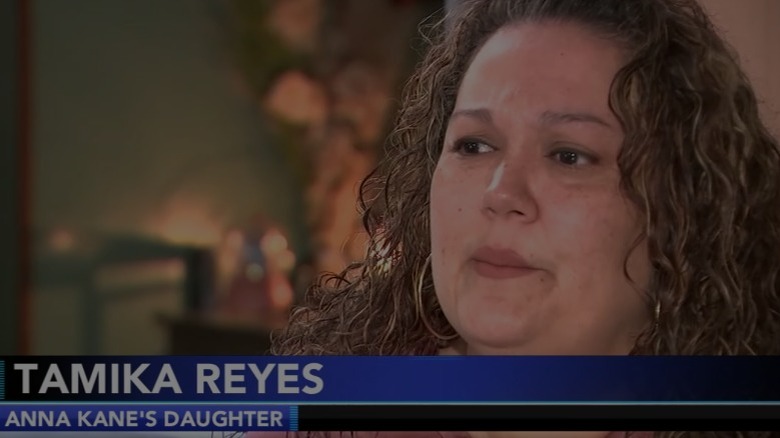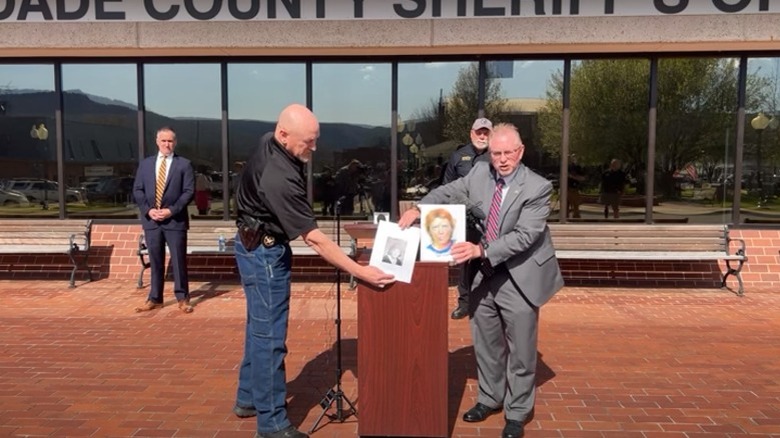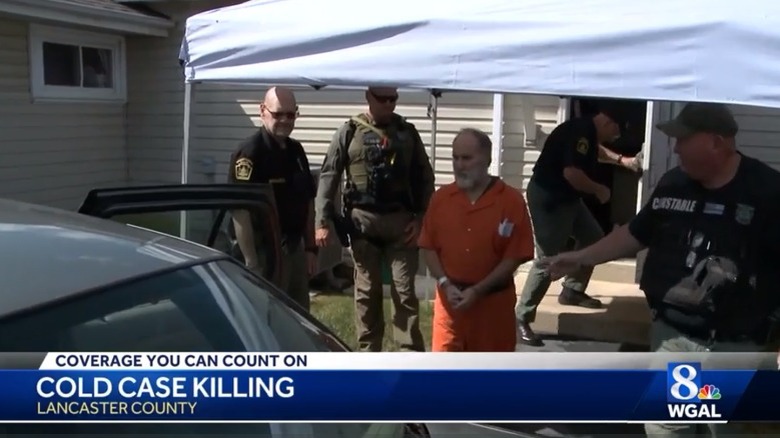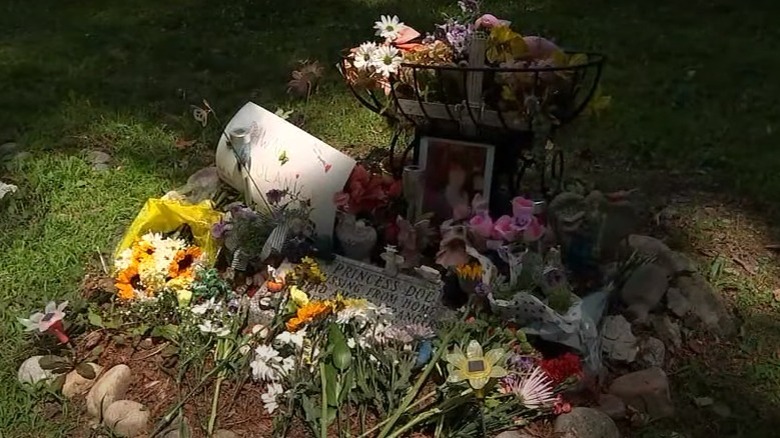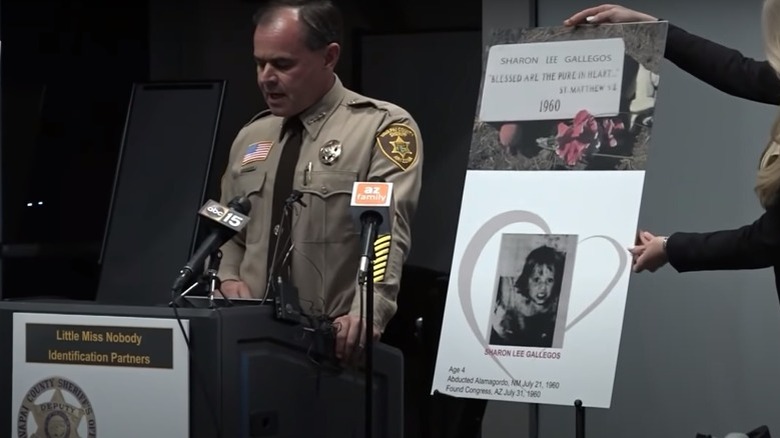12 Cold Cases Solved In 2022
If you've ever thought that you may make a good homicide investigator, there is one important qualification (other than having an exceptionally strong stomach) that you should know about. You see, homicide cases — as you likely realize from the six thousand true-crime documentaries which set you on this career path in the first place — can often take a very long time to resolve. Leads fail to pan out, witnesses change their tunes or disappear altogether, and collected evidence fails to provide the iron-clad proof required for an arrest and conviction; for mere mortals, it can all become exceedingly frustrating. This is why, in order to be a successful homicide detective, one must be possessed of an absolutely superhuman, ridiculously dogged level of determination.
Fortunately, the profession seems to attract those who have this quality, as proven by the many decades-old cases which finally see their resolutions every single year. In addition to providing closure for the families and friends of the victims, every closed cold case serves another important purpose: Letting those who commit murder know that homicide investigators are the Terminators of law enforcement, and that (to paraphrase Kyle Reese) they will not stop — EVER! — until you are in jail. Here are a dozen of the most stubbornly unresolved cold cases that were finally put to bed in 2022.
Anna Kane
Tamika Reyes was only nine years old when her mother, 26-year-old Anna Kane, was found strangled and left in the woods outside of Reading, Pennsylvania, in 1988. According to CNN, police were bereft of leads despite the local newspaper running a front-page story seeking information from the public — until 15 months later, when a mysterious letter from a "concerned citizen" appeared on the editor's desk. That letter happened to contain information that only the killer would be privy to, and saliva on the envelope was matched to that found on Kane's clothing. However, this was the '80s, and it would take a while for the science of genetic genealogy to help the cops pin down their suspect.
This finally happened in 2022, when DNA information provided to public websites by members of the killer's family allowed authorities to focus on Scott Grim, a resident of the area who had never been charged with any crime. Grim died in 2018, but through an undisclosed method, police were able to obtain a sample of his DNA to match the evidence retrieved from the letter. While the identification of Kane's killer provided a measure of closure to her daughter, Reyes was understandably disappointed that Grim had eluded justice by way of dying. "I was happy to finally put a face behind the monster who took her from us," she said, "[but] upset that he will never be able to face consequences."
Asenath Dukat
The 1980 murder of Asenath Dukat was one that shook the Columbus, Ohio community for a simple reason. Dukat was only 8 years old, grabbed by a stranger and killed with a 20-pound rock in a shallow stream on her short walk home from school, according to the Columbus Dispatch. Police theorized that the killing may have been part of a pattern of attempted child abductions going on at the time, and over the years following, they investigated a slew of potential suspects, even resorting to the not-so-solid technique of hypnotizing subjects in their attempts to elicit a confession.
Like so many other cold cases, the eventual identification of the killer hinged on one thing: The collection of DNA evidence at the scene of the murder, and its careful preservation. In 2008, police were alerted to a potential match with the recently-obtained DNA profile of Brent Strutner, a local who had died by suicide in 1984 and who was among the original batch of suspects. Over the next 14 years, authorities diligently ruled out the presence of any DNA not matching Strutner's in the 1980 evidence — and finally, in 2022, he was named as Dukat's murderer.
Brittanee Drexel
In 2009, Dawn and Chad Drexel lived every parent's worst nightmare. In April of that year, their 17-year-old daughter Brittanee took off for spring break, without her parents' permission, to Myrtle Beach, Florida, and never came home (via Democrat & Chronicle). The man who would eventually be named as her killer, Raymond Moody, had been a person of interest in Brittanee Drexel's disappearance as far back as 2012 — but until just recently, they had nothing solid connecting him to the crime.
This time, it wasn't advances in DNA technology that helped crack the case, but in technology of a different sort: GPS. Using data from Brittanee's cell phone, authorities were finally able to pinpoint the location of Brittanee's disappearance more effectively than in previous attempts, which led to the discovery of a surveillance video implicating Moody in the crime, as reported by Democrat & Chronicle. Moody confessed and led investigators to Brittanee's remains, but his belated cooperation did nothing to keep the entire book from getting thrown at him in court. In October 2022, Moody was sentenced to life in prison plus two consecutive 30-year stretches, ensuring that the now-62-year-old will never walk free again.
Joette Smith
The murder of 33-year-old Santa Cruz, California, restaurant owner Joette Smith was precipitated by what should have been an innocuous circumstance. One March day in 1983, she turned down a stranger's request for a date — and a short time later, her body was pulled from a nearby river (pictured), shocking what was at the time a cozy, tight-knit community, according to the Los Angeles Times. Her killer, Eric Drummond, was a customer at her restaurant, and it's likely due to the lack of an obvious connection with Smith that it took police five years to even identify him as a suspect.
As with many such cases, the DNA evidence taken from Smith's body was insufficient to pin the crime on Drummond in the '80s, and although there was significant circumstantial evidence of his involvement, he walked free for nearly four decades. The cops never took their eye off of Drummond despite the fact that he left the state shortly after committing the crime, and when improved DNA technology allowed them to develop a sturdy profile of Smith's killer, they zeroed in on him in earnest. In September 2022, Drummond died by suicide as the police were closing in — a life that almost certainly would have been lived out in the slammer otherwise. In a statement announcing the closure of the investigation, the Santa Cruz County Sheriff's Office stated its confidence that "the evidence in this case would support a conviction of Drummond for the murder of Joette Smith."
Stacey Chahorski
In 1988, state authorities in Georgia were presented with a crime that would seem nearly impossible to solve: The killing of 19-year-old Stacey Chahorski, whose body was found alongside a highway near the state's border with Alabama. The difficulty lay in the fact that not only was the available DNA evidence too weak to pinpoint a suspect, but, at the time, the victim herself was also unidentified.
According to WRDW News, the case is believed to be the first time that both a murder victim and perpetrator were identified using DNA technology in the same case. Decades after the fact, family members of Hank Wise, a trucker with an extensive criminal history spanning three states, came forward to provide DNA that would be matched to evidence found at the scene. Chahorski was likewise identified through the DNA of living relatives, finally putting a lid on a case that had stumped investigators for 34 years. Wise died in a car crash in 1999, but that fact did nothing to diminish the power of the statement given by the FBI's Atlanta office in the wake of the resolution of the case. "Let this serve as a warning to every murderer, rapist, and violent offender out there," said Keri Farley, special agent in charge of the investigation. "The FBI and our partners will not give up. It may take years or even decades, but we continually seek justice for victims and their families."
Lindy Sue Biechler
The most stubborn cold case in the history of Lancaster County, Pennsylvania, was finally cracked in 2022 thanks to an ingenious piece of investigative work. In 1975, long before DNA evidence would become a factor in criminal justice, 19-year-old Lindy Sue Biechler was brutally stabbed to death inside her home. According to NPR, the investigation into the crime went nowhere for decades, until the resolution of a cold case in a nearby county prompted investigators to use blood evidence from the scene to attempt to whittle down their suspect list.
Using genealogy techniques, detectives discovered that the murderer had ancestral origins in the small Italian town of Gasperina, and that only a couple thousand people with such ties lived in the area at the time of the killing. Using court records, news reports, and good old-fashioned police work, investigators then determined that one of those people — 68-year-old David Sinopoli — lived in the same apartment complex as Biechler in 1975. Detectives began watching Sinopoli, and before he boarded a flight at Philly International Airport, they collected a discarded coffee cup that provided the DNA sample they needed to nail him. In this case, it appears justice will indeed be served; as of this writing, Sinopoli is being held without bail, awaiting trial for Biechler's murder.
John Stagner
When 53-year-old John Stagner was beaten to death in his bed in Orlando, Florida, in 1992, police honed in on a suspect almost immediately, according to Fox 35 Orlando: Ronald Cates, a friend of Stagner's who happened to be a drug addict. Cates had developed a habit of borrowing and pawning power tools from Stagner, a city maintenance worker, in order to support this habit; even Cates' own family members had long suspected his involvement in the killing, but police were never able to gather enough evidence to support a probable cause warrant for his arrest.
That changed in 2022 when those family members — who had long lived in fear of Cates and his abusive, violent tendencies — came forward to do a fresh round of interviews with police. As it happened, around this same time, Cates was in the hospital in North Carolina, and as Florida detectives were shoring up their case, Cates blurted out to a nurse that he had killed someone in Florida decades prior. The nurse told a security guard, who relayed the information to Orlando police, who paid a visit to Cates in the hospital — where they were able to obtain a confession on an officer's body cam. It was the rare case in which a fleeting moment of conscience, and not new technology, was the key to unraveling a three-decade-old crime.
James Tappen Hall
There are cold cases, and then there is the murder of James Tappen Hall, a Montgomery County (Maryland) Sheriff's deputy who was moonlighting as a security guard at a local country club when he was shot in the club's parking lot in October 1971. He died in the hospital three days later, and his murder would become the oldest such unsolved crime in the history of the county, according to the New York Post.
The case lay dormant for years until, on the occasion of the 50th anniversary of the killing in 2021, investigators decided to take a fresh look. Going over the old case files, they zeroed in on Larry David Smith, who had been interviewed in connection with the slaying in 1973 but was never seriously considered a suspect. Investigators discovered, however, that soon after that interview, Smith had moved to Little Falls, New York, and changed his surname to Becker — a circumstance that prompted them to bring him in for a new round of interviews. When they did, the now-elderly killer — presumably weary from looking over his shoulder for 45 years — broke down and confessed to the crime.
Hall's daughter, happy to finally have closure, had a message for those facing the unsolved murder of a loved one: "Please don't give up. Please keep after. The police don't give up."
Joyce Meyer
In December 1996, police stumbled upon a mystery fit for a detective novel. At a cemetery in Annandale, Virginia (pictured), the body of a middle-aged woman was found. In her pockets were two notes and some cash; one note clarified to police that the death had been a suicide, and the other directed them to use the cash for funeral expenses. Both were signed "Jane Doe," and despite their best efforts, police were unable to identify the woman who would become known as the "Christmas tree lady" (via DC News Now).
In May 2022, genome sequencing technology became available to the Fairfax police department, enabling investigators to reach out to potential family members. After more than 25 years, she was finally identified as Joyce Meyer, a woman who had drifted apart from her family after moving to Virginia in the mid-'80s. In a statement, the Fairfax County Sheriff's Department thanked "several generations of FCPD detectives" along with Othram, the company that supplied the genome sequencing technology — and expressed its conviction that said the technology will help them to resolve many more unsolved cases in the future.
Dawn Olanick
The case of the young woman known as "Princess Doe" is just a bit unusual in that the man responsible for the crime was identified by police long before the victim was. When the 17-year-old was found beaten to death in a New Jersey cemetery in July 1982, the small community of Blairstown responded with an outpouring of sympathy, raising funds for her burial and keeping the case in the public eye, according to the New Jersey Herald. The case gained national attention, even serving as the basis of an HBO special in 1983; justice, though, was a long time in coming.
The case was partially resolved in 2005 when Richard Kinlaw — serving a 20 years-to-life sentence in prison for the murder of another woman — confessed in writing to Princess Doe's murder. But it wasn't until 2022 that, you guessed it, advances in DNA technology finally allowed authorities to use an imperfect DNA profile to identify the victim as Dawn Olanick, whom it is believed Kinlaw murdered when she resisted his attempt to coerce her into prostitution. Despite his confession, Kinlaw couldn't be charged with the murder until positive identification of his victim was made — and with that accomplished, a first-degree murder charge was filed against him in July 2022.
Lina Reyes Geddes
Another victim of a brutal murder who went unidentified for decades, Lina Reyes Geddes was found near a spring in the vicinity of Lake Powell, Utah, in 1998, shot, bound, and wrapped in a sleeping bag. The main problem with positively identifying her was the fact that her fingertips had been cut off, and entreaties to the public for help yielded nothing, according to The Salt Lake Tribune. Nothing, that is, until 2018, when an amateur cold case enthusiast came forward with one tiny detail after police reopened the case.
That detail was a small mole on Geddes' right ear, which was enough for police to make a tenuous connection to Geddes. Acting on the suspicions of her family in Mexico, authorities examined trace DNA from the ropes used to bind her, comparing it with DNA given by the family of Edward Geddes (pictured), Lina's husband, who had died by suicide in 2001. A match was made, confirming Edward Geddes as the murderer and giving a modicum of closure to the family of Lina Reyes Geddes, who for 20 years had been known to Utah law enforcement only as the "Maidenwater victim," after the area in which she was found.
Sharon Lee Gallegos
In the summer of 1960, the body of a young girl was found near a highway in Yavapai Country, Arizona. Due to decomposition, it was tough to determine the girl's age, let alone her identity; at the time, authorities believed her to be about 7 years old. This would prove to be an incorrect guess, and as there was a dearth of reported missing child cases involving children of that age, police hit a dead end in the case of the girl who would become known to locals as "Little Miss Nobody" (via CBS News).
That heartbreaking nickname was retired forever in 2022, thanks to DNA retrieved from the little girl's remains in 2015. As we've seen, DNA technology is growing by leaps and bounds every year — and while no workable DNA profile could be created at that time, it was a different story just seven years later. Using DNA from living relatives, the little girl was finally identified as Sharon Lee Gallegos, a 4-year-old who was abducted from her grandmother's home in Alamagordo, New Mexico — 500 miles from where her body had been discovered — in July 1960. Unfortunately, the 62-year-old mystery has only been partially solved — the cops are still on the lookout for Gallegos' abductor, although it seems a safe bet that if they're still alive, the extremely long, doggedly determined arm of the law will catch up to them eventually. As for the moniker "Little Miss Nobody," Yavapai County Sheriff David Rhodes had only one succinct comment: "I hope we never hear that name again."

